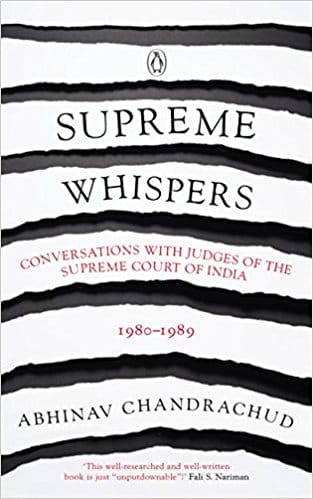
Written by Abhinav Chandrachud, the book explores the trajectory of dissenting opinions in judicial pronouncements among other issues.
From judicial appointments and judicial pronouncements to the system of filing special leave petitions, here is a new book that proves that it is not the said but the unsaid that provides rationale to the law. Written as a historical account, the book, ‘Supreme Whispers’ by Abhinav Chandrachud reinforces the premise that neutrality of judiciary is a myth, as the worldview of the judges often guides legal development.
Based on the interviews conducted by University of Kentucky’s Prof. George H. Gadbois Jr. of Supreme Court Judges, the book traces the politics of law during 1980-89 and offers fascinating insights into what happens behind the bench and in the process humanises the judiciary. These snippets of information also underline how the ability of individuals to rise above their biases is essential for protecting the institutional integrity. Ideological leanings, caste and regional considerations rather than merit have often determined the appointment of judges.
Even before the debate on judicial appointment gained such traction, judicial appointments were influenced by the personal leanings of both the judiciary and the executive. Several examples have been cited in the book wherein a meritorious individual was refused judicial position because of his/her independent thought or refusal to walk the government’s line of thought.
One of the chapters of this book explores the trajectory of dissenting opinions in judicial pronouncements. Interestingly, despite professional rivalries, dissenting judgments were written only in 8 per cent of the cases decided by the Supreme Court between 1950 and 1967. In a time when the space for dissent is constantly shrinking, this chapter explores its role in the arena of law making.
Dissenting opinions showcase the ideological diversity of the bench and are a powerful way of introducing new narratives into law making. However, this chapter indicates how dissents are not a common feature of judicial pronouncements in India and are written only in case of irreconcilable disagreements.
In another chapter, the author analyses the reasons why several individuals refused judgeship. However, more often than not, individuals have accepted this opportunity because of the prestige attached to it.
This method of understanding law through inconspicuous but crucial events is rarely seen in Indian legal writings. Gadbois’ accounts paired with Chandrachud’s meticulous analysis make this book an interesting read. However, the readers should be wary of assuming it to be the absolute truth as even an objective account is never free of value judgments.
Anumeha Mishra is an assistant professor, Faculty of Law, University of Delhi


COMMENTS